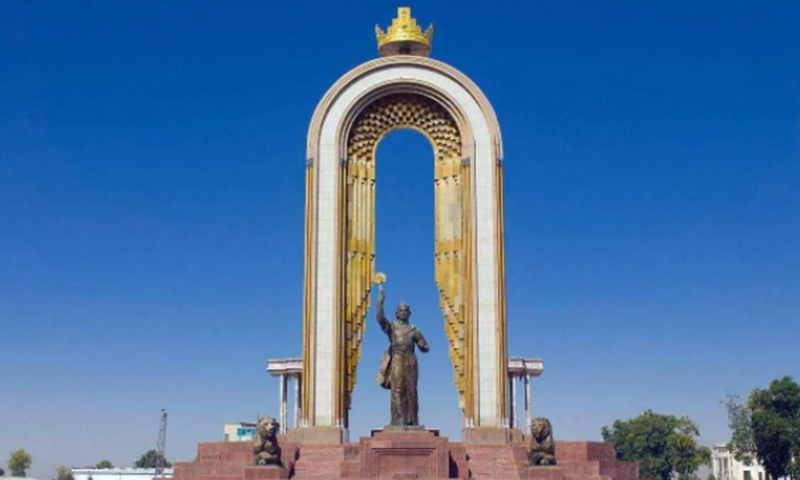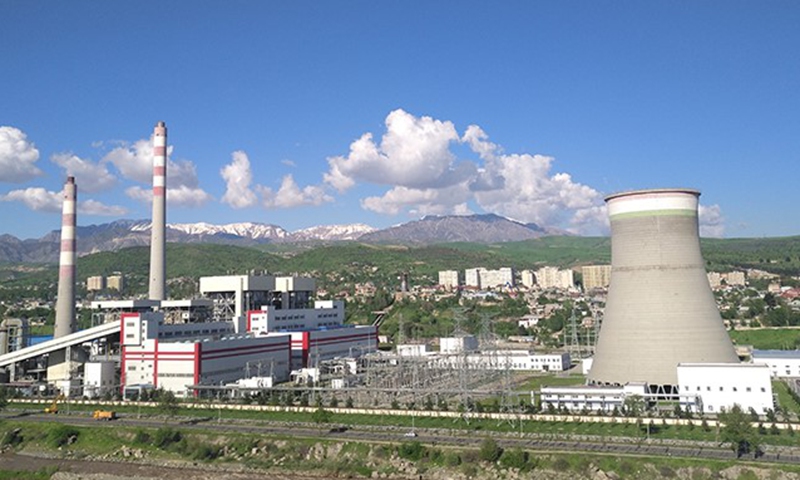Located at latitude 38.5 and longitude 68.8 is Dushanbe, the capital of Tajikistan. In December, as winter bursts into this city, night in Dushanbe can be as long as 14 hours. The city is in the furthest inland of the Eurasian continent, over 1,600 kilometers away from the nearest ocean. The north wind from Siberia sweeps through mountains, covering the Ismoil Somoni Peak with fine snow. The downtown square is empty, and the howling north wind seems to become the master of the city, dancing on the square and covering the Statue of Ismoil Samani with a thick layer of frost.

In 2011, the Tajik government and China's Xinjiang Tebian Electric Apparatus (TBEA) signed an agreement on the construction of the Dushanbe No.2 thermal power plant. Officially launched in October 2012, the project is aimed at resolving the shortage of power supply in winter and adjusting the national power supply structure. As was previously agreed, the No.2 thermal power plant project has not only created 600 local jobs, but also helped to train a group of outstanding professionals. Young engineer Sikhmaduro Zoylov is one of them. He came to China in 2012 to study thermal power technology. Zoylov said affectionately that he has witnessed together with his Chinese friends this power plant developing from scratch, and he was deeply impressed by the professionalism his Chinese colleagues demonstrated in their work and the advanced equipment on the construction site.
Apart from ensuring power supply for heating, protecting the beautiful natural environment of Dushanbe is also a priority of the project. Since day one of construction and throughout the entire process, the concept of green development has always been a guiding principle. World-class technology standards, and environmental protection technologies and equipment are adopted. Real-time monitoring of pollutant emissions is used. Waste generated during construction including ashes is recycled and reused.
The leaders of China and Tajikistan have attached great importance to this key project that promotes Tajikistan's economic development and benefits people's livelihood. In September 2014, during a state visit to Tajikistan, President Xi Jinping, together with Tajik President Emomali Rahmon, attended the ceremony marking the completion and ignition of the first phase of the power plant and the groundbreaking of the second phase. President Xi said that the Dushanbe No.2 thermal power plant is a landmark project of the pragmatic cooperation between China and Tajikistan, and a symbol of the friendship between the two peoples. President Rahmon praised the No.2 thermal power plant for improving the country's capacity to ensure energy sufficiency, calling it a model of high-level cooperation between Tajikistan and China.

The Ismoil Somoni Peak is now decorated with high-voltage towers — an industrial aesthetics under the blue sky and white clouds. The voices of young students reading can be heard in the schools of Dushanbe, and the warmth sent by the power plant can be felt in every household. Billboards in Chinese are everywhere in the streets. Take a cab in Dushanbe, and you will be greeted with a "ni hao" (hello) in fairly standard Chinese accent.
Sorov, or "Old So" as others affectionately call him, has three sons. His eldest son works as a Chinese interpreter at No.2 thermal power plant. His second son is now studying in China and has a Chinese girlfriend. His youngest son is studying Chinese at the Confucius Institute in Tajikistan and plans to study in China. All these have a lot to do with Old So's connections with China. In 2007, he joined a local Chinese company and has worked there as a driver, guide, interpreter, and technician. He has been involved in many energy projects, and witnessed with his own eyes how the No.2 thermal power plant has brought well-being to his country and the people. He said that China has made a genuine effort to help Tajikistan, China has brought brightness and warmth to the Tajik people, and he himself was proud to work in a Chinese enterprise.
Tajikistan is not only one of the first countries to publicly support the Belt and Road Initiative, but also one of the first to join the Asian Infrastructure Investment Bank. Today, it is transforming from a country supported mainly by agriculture and animal husbandry to a modern industrial country. The potential for energy cooperation between China and Tajikistan is unlimited, and the friendship between the people of China and Tajikistan will be passed on from generation to generation.

the Statue of Ismoil Samani
Inland location brought about transportation inconvenience in Tajikistan. More than 90 percent of the land is mountains and plateaus. While endowing the country with rich hydropower resources, they cause a shortage of power supply during the dry season in winter. The country had to implement a nationwide power rationing. Its pursuit to meet people's basic living needs and improve their living standards had been held down by such constraints.In 2011, the Tajik government and China's Xinjiang Tebian Electric Apparatus (TBEA) signed an agreement on the construction of the Dushanbe No.2 thermal power plant. Officially launched in October 2012, the project is aimed at resolving the shortage of power supply in winter and adjusting the national power supply structure. As was previously agreed, the No.2 thermal power plant project has not only created 600 local jobs, but also helped to train a group of outstanding professionals. Young engineer Sikhmaduro Zoylov is one of them. He came to China in 2012 to study thermal power technology. Zoylov said affectionately that he has witnessed together with his Chinese friends this power plant developing from scratch, and he was deeply impressed by the professionalism his Chinese colleagues demonstrated in their work and the advanced equipment on the construction site.
Apart from ensuring power supply for heating, protecting the beautiful natural environment of Dushanbe is also a priority of the project. Since day one of construction and throughout the entire process, the concept of green development has always been a guiding principle. World-class technology standards, and environmental protection technologies and equipment are adopted. Real-time monitoring of pollutant emissions is used. Waste generated during construction including ashes is recycled and reused.
The leaders of China and Tajikistan have attached great importance to this key project that promotes Tajikistan's economic development and benefits people's livelihood. In September 2014, during a state visit to Tajikistan, President Xi Jinping, together with Tajik President Emomali Rahmon, attended the ceremony marking the completion and ignition of the first phase of the power plant and the groundbreaking of the second phase. President Xi said that the Dushanbe No.2 thermal power plant is a landmark project of the pragmatic cooperation between China and Tajikistan, and a symbol of the friendship between the two peoples. President Rahmon praised the No.2 thermal power plant for improving the country's capacity to ensure energy sufficiency, calling it a model of high-level cooperation between Tajikistan and China.

Dushanbe No.2 thermal power plant
In 2017, Tajikistan bid farewell to its 20 years of power shortages. From then on, winter is no longer cold in Dushanbe.The Ismoil Somoni Peak is now decorated with high-voltage towers — an industrial aesthetics under the blue sky and white clouds. The voices of young students reading can be heard in the schools of Dushanbe, and the warmth sent by the power plant can be felt in every household. Billboards in Chinese are everywhere in the streets. Take a cab in Dushanbe, and you will be greeted with a "ni hao" (hello) in fairly standard Chinese accent.
Sorov, or "Old So" as others affectionately call him, has three sons. His eldest son works as a Chinese interpreter at No.2 thermal power plant. His second son is now studying in China and has a Chinese girlfriend. His youngest son is studying Chinese at the Confucius Institute in Tajikistan and plans to study in China. All these have a lot to do with Old So's connections with China. In 2007, he joined a local Chinese company and has worked there as a driver, guide, interpreter, and technician. He has been involved in many energy projects, and witnessed with his own eyes how the No.2 thermal power plant has brought well-being to his country and the people. He said that China has made a genuine effort to help Tajikistan, China has brought brightness and warmth to the Tajik people, and he himself was proud to work in a Chinese enterprise.
Tajikistan is not only one of the first countries to publicly support the Belt and Road Initiative, but also one of the first to join the Asian Infrastructure Investment Bank. Today, it is transforming from a country supported mainly by agriculture and animal husbandry to a modern industrial country. The potential for energy cooperation between China and Tajikistan is unlimited, and the friendship between the people of China and Tajikistan will be passed on from generation to generation.



